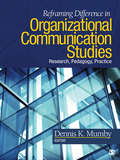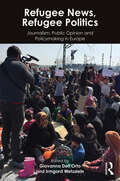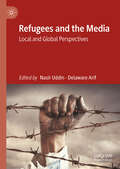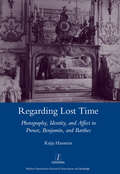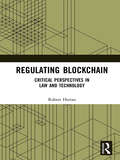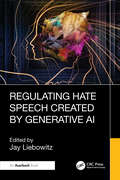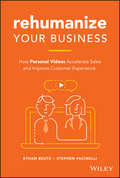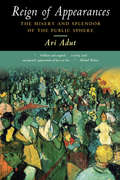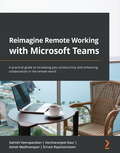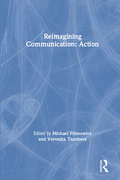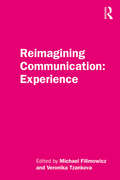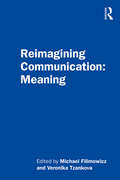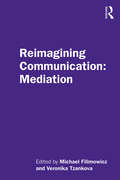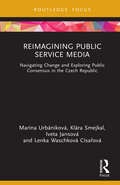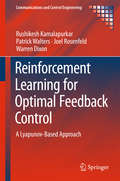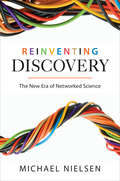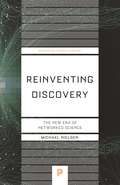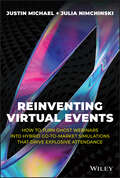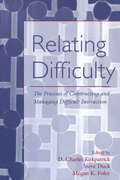- Table View
- List View
Reframing Difference in Organizational Communication Studies: Research, Pedagogy, and Practice
by Dennis K. MumbyThe first text to systematically examine difference as a defining feature of organizational life Bringing together prominent scholars in the field of organizational communication to examine the relationship between difference and organizing, this book explores the concept in a comprehensive and systematic way. Part I explores numerous ways in which difference can be critically examined as a communicative phenomenon; Part II addresses how best to teach difference, including pragmatic recommendations for explaining the topic and making it relevant to students′ lives; and Part III broadly examines difference as a central construct in applied organizational communication research. Ultimately, the book serves to carve out a new agenda for studies of difference and organization, and it challenges instructors and students alike to think about and explore difference in a more complex and productive manner.
Refugee News, Refugee Politics: Journalism, Public Opinion and Policymaking in Europe
by Irmgard Wetzstein Giovanna Dell’OrtoThe unprecedented arrival of more than a million refugees, asylum seekers, and migrants – plus the political, public, and policy reactions to it – is redefining Europe. The repercussions will last for generations on such central issues as security, national identity, human rights, and the very structure of liberal democracies. What is the role of the news media in telling the story of the 2010s refugee crisis at a time of deepening crisis for journalism, as “fake news” ran rampant amid an increasingly distrustful public? This volume offers students, scholars, and the general reader original research and candid frontline insights to understand the intersecting influences of journalistic practices, news discourses, public opinion, and policymaking on one of the most polarizing issues of our time. Focusing on current events in Greece, Austria, and Germany – critical entry and destination countries – it introduces a groundbreaking dialogue between elite national and international media, academic institutions, and civil society organizations, revealing the complex impacts of the news media on the thorny sociopolitical dilemmas raised by the integration of hundreds of thousands of asylum seekers in EU countries.
Refugees and the Media: Local and Global Perspectives
by Nasir Uddin Delaware ArifMedia and refugees rhetorically live together and practically complement each other. Yet, it involves plenty of hidden political agendas and ethical issues in the (re)presentation of refugees in media. This collection raises questions: Should the media stand by refugees or maintain deliberate ‘neutrality’? Should the media dehumanize the refugees further in their humanitarian conditions? Are the media entitled to publish photographs of refugees without informed consent? Should the media stand by the state being responsible for generating refugee crisis or should the state be accountable for rendering its people refugees? What effective roles can media play in redressing the refugee ‘crisis’ in the world? The book brings together scholars across disciplines and continents who reflect on the nexus between media and refugees in contexts around the world. It engages in cutting-edge methodological and theoretical discussions and challenges regarding the reciprocal engagement between media and refugees from both local and global perspectives.
Regarding Lost Time: Photography, Identity and Affect in Proust, Benjamin, and Barthes
by Katja HausteinWhat is autobiography and how does it transform in the age of technological reproducibility? Katja Haustein discusses this question as it relates to photography and the role of emotion in Marcel Proust's In Search of Lost Time (1909-22), Walter Benjamin's Berlin Childhood around 1900 (1932-38), and Roland Barthes's Roland Barthes (1977) and Camera Lucida (1980). In her close critical readings, Haustein provides the first comprehensive comparative analysis of these popular works, mapping them against little-studied textual, visual and aural material, some of which has only recently become accessible. In this way, her book opens new avenues in scholarship dedicated to three outstanding twentieth-century writers and contributes to a field of critical inquiry that is still in the making: the history of autobiography in the light of a history of the gaze.
Regarding the Pain of Others
by Susan SontagHow does the spectacle of the sufferings of others (via television or newsprint) affect us? Are viewers inured--or incited--to violence by the depiction of cruelty? In Regarding the Pain of Others, Susan Sontag takes a fresh look at the representation of atrocity-from Goya's The Disasters of War to photographs of the American Civil War, lynchings of blacks in the South, and the Nazi death camps, to contemporary horrific images of Bosnia, Sierra Leone, Rwanda, Israel and Palestine, and New York City on September 11, 2001. In Regarding the Pain of Others Susan Sontag once again changes the way we think about the uses and meanings of images in our world, and offers an important reflection about how war itself is waged (and understood) in our time.
Regardless of Frontiers: Global Freedom of Expression in a Troubled World
by Lee C. Bollinger and Agnès CallamardThe United Nations’ Universal Declaration of Human Rights in 1948 proclaimed a vision of freedom of expression exercised regardless of frontiers. Nonetheless, laws and norms regarding the freedom or limits of expression are typically established and understood at the national level. In today’s interconnected world, newfound threats to free expression have suddenly arisen. How can this fundamental right be secured at a global level?This volume brings together leading experts from a variety of fields to critically evaluate the extent to which global norms on freedom of expression and information have been established and which actors and institutions have contributed to their diffusion. The authors also consider ongoing and new challenges to these norms, from conflicts over hate speech and the rise of populism to authoritarian governments, as well as the profound disruption introduced by the internet. Together, the essays lay the groundwork for an international legal doctrine on global freedom of expression that considers issues such as access to government-held information, media diversity, and political speech. As the world risks renouncing previous commitments to the freedom of expression, Regardless of Frontiers serves as a timely reminder of just how much is at stake and what needs protecting.
Registerial Expertise in Traditional Chinese Medical Translation (Routledge Studies in Language, Health and Culture)
by Yan YueYue’s book explores the nature of translation using traditional Chinese medicine (TCM) and the TCM classic Huangdi Neijing and its various translations. Yue examines in great detail and depth the important factors that cause the differences in the translators’ treatment of language indeterminacies. Apart from having multi-faceted and fine-grained linguistic analysis, this book also serves as a good model of methodology, in terms of corpus building, contrastive analysis, exemplification, and glossing following systemic functional linguistics (SFL) convention. This book is an argument for greater emphasis on the linguistic notion of register in translator’s expertise, specifically in the way that professional experience and training – with their registerial demands – may be the key to semantic decisions forced on a translator by the inevitable vagaries and indeterminacies of establishing a working “equivalence” across languages and cultures and deep time. It probes the issue in an extreme case: the debate over who is the “ideal” translator in Chinese medicine translation through various case studies. The result suggests it is possible to demonstrate, empirically, that clinical experience in translators is likely to have consistent, or even measurable, consequences.This book will be of interest to three different fields: translators in training, applicable systemic functional linguistics, and traditional Chinese medicine communication.
Regulating Blockchain: Critical Perspectives in Law and Technology
by Robert HerianAs the distributed architecture underpinning the initial Bitcoin anarcho-capitalist, libertarian project, 'blockchain' entered wider public imagination and vocabulary only very recently. Yet in a short space of time it has become more mainstream and synonymous with a spectacular variety of commercial and civic 'problem'/'solution' concepts and ideals. From commodity provenance, to electoral fraud prevention, to a wholesale decentralisation of power and the banishing of the exploitative practices of 'middlemen', blockchain stakeholders are nothing short of evangelical in their belief that it is a force for good. For these reasons and more the technology has captured the attention of entrepreneurs, venture capitalists, global corporations and governments the world over. Blockchain may indeed offer a unique technical opportunity to change cultures of transparency and trust within cyberspace, and as ‘revolutionary’ and ‘disruptive’ has the potential to shift global socioeconomic and political conventions. But as a yet largely unregulated, solutionist-driven phenomenon, blockchain exists squarely within the boundaries of capitalist logic and reason, fast becoming central to the business models of many sources of financial and political power the technology was specifically designed to undo, and increasingly allied to neoliberal strategies with scant regard for collective, political or democratic accountability in the public interest. Regulating Blockchain casts a critical eye over the technology, its ‘ecosystem’ of stakeholders, and offers a challenge to the prevailing discourse proclaiming it to be the great techno-social enabler of our times.
Regulating Hate Speech Created by Generative AI
by Jay LiebowitzRegulating Hate Speech Created by Generative AI explores the new hybrid space of Human Machine Interaction (HMI) in which hate speech is represented and computed through algorithms and AI generative systems. The book is exploratory because there are still many problem-solving challenges to be faced. It is also innovative because it is not assuming that solutions lie only in technological advancements but on a broader scale. In this sense, large language models can and are being considered from a holistic view (i.e., from the different dimensions and layers of regulatory and legal governance). Highlights of the book include: Generative AI and social engines of hate An introduction to generative Artificial Intelligence application, trends, and ethics The mechanics and validation of generative AI outcomes An evaluation of Generative AI for hate speech detection Best practices and key considerations for AI regulation Using GenAI capabilities for early detection of threats in the digital environment. This book is a hard look at ways to regulate generative AI to reduce online hate and secure justice in a digital environment. Featuring research and offering practical guidelines, the book examines guidelines for regulating generative AI models, so they do not contribute to online hate disinformation and imagery.
Rehumanize Your Business: How Personal Videos Accelerate Sales and Improve Customer Experience
by Ethan Beute Stephen PacinelliAccelerate sales and improve customer experience Every day, most working professionals entrust their most important messages to a form of communication that doesn't build trust, provide differentiation, or communicate clearly enough. It's easy to point to the sheer volume of emails, text messages, voicemails, and even social messaging as the problem that reduces our reply rates and diminishes our effectiveness. But the faceless nature of that communication is also to blame. Rehumanize Your Business explains how to dramatically improve relationships and results with your customers, prospects, employees, and recruits by adding personal videos to emails, text messages, and social messages. It explains the what, why, and how behind this new movement toward simple, authentic videos—and when to replace some of your plain, typed-out communication with webcam and smartphone recordings. • Restore face-to-face communication for clarity and connection • Add a personal, human touch to your emails and other messages • Meet people who’ve sent thousands of videos • Learn to implement your own video habit in an easy, time-saving way • Boost your replies, appointments, conversion, referrals, and results dramatically If you’re ready to influence, teach, sell, or serve in a more personal way, Rehumanize Your Business is your guide.
Rehumanizing Law
by Randy GordonIn a popular sense, 'law' connotes the rules of a society, as well as the institutions that make and enforce those rules. Although laws are created and interpreted in legislatures and courtrooms by individuals with very specialized knowledge, the practice and making of law is closely tied to other systems of knowledge. To emphasize this often downplayed connection, Rehumanizing Law examines the law in relation to narrative, a fundamental mode of human expression.Randy D. Gordon illustrates the bridge between narrative and law by considering whether literature can prompt legislation. Using Upton Sinclair's The Jungle and Rachel Carson's Silent Spring, Gordon shows that literary works can figure in important regulatory measures. Discussing the rule of law in relation to democracy, he reads Melville's Billy Budd and analyzes the O.J. Simpson and Rodney King cases.This highly original and creative study reconnects the law to its narrative roots by showing how and why stories become laws.
Reign of Appearances: The Misery And Splendor Of The Public Sphere
by Ari AdutThe public sphere, be it the Greek agora or the New York Times op-ed page, is the realm of appearances - not citizenship. Its central event is spectacle - not dialogue. <P><P>Public dialogue, the mantra of many intellectuals and political commentators, is but a contradiction in terms. Marked by an asymmetry between the few who act and the many who watch, the public sphere can undermine liberal democracy, law, and morality. Inauthenticity, superficiality, and objectification are the very essence of the public sphere. But the public sphere also liberates us from the bondages of private life and fosters an existentially vital aesthetic experience. <P>Reign of Appearances uses a variety of cases to reveal the logic of the public sphere, including homosexuality in Victorian England, the 2008 crash, antisemitism in Europe, confidence in American presidents, communications in social media, special prosecutor investigations, the visibility of African-Americans, violence during the French Revolution, the Islamic veil, and contemporary sexual politics. <P>This unconventional account of the public sphere is critical reading for anyone who wants to understand the effects of visibility in urban life, politics, and the media.<P>Challenges the common wisdom that the public sphere is always good for democracy.<P> Asserts that spectatorship - and not civic participation - is the essence of the public sphere.<P> Argues that spectatorship, which is a much-disdained stance, is an existentially vital aesthetic experience.
Reimagine Remote Working with Microsoft Teams: A practical guide to increasing your productivity and enhancing collaboration in the remote world
by Sathish Veerapandian Harsharanjeet Kaur Ashok Madhvarayan Sriram RajamanickamGet a 360-degree view of Teams as a secure collaboration tool with best practices and recommendations for using Teams efficientlyKey FeaturesMaster and manage virtual meetings easily using TeamsUnderstand the essential security and administration aspects of Microsoft TeamsCommunicate and collaborate effectively with your colleagues using Teams and M365 apps such as Sway, Yammer, and StreamBook DescriptionThe outbreak of the pandemic has forced the world to embrace remote working and the modern style of virtual business. However, end users may find it challenging to cope with this sudden change in working style, not aware of all the features and remote working tools available to make their life easy. Microsoft Teams is an exceptional platform, adopted by many organizations for unified communication and collaboration, and this book will help you to make the most of its capabilities. Complete with step-by-step explanations and screenshots, this book guides you through the topics that you'll find useful in your daily use of Teams. You'll learn how to manage your teams and projects with Microsoft Teams in a structured and organized way. The book provides hands-on information with a focus on the end user side to help corporate users to increase productivity and become a Microsoft Teams superuser. Finally, you'll explore the most effective ways of using the app with best practices and tips and tricks for making the most of the features available for your scenario. By the end of this Microsoft Teams book, you'll have mastered Microsoft Teams and be fully equipped as a modern collaboration end user to effectively increase your remote work productivity.What you will learnFind out how to secure your documents and data with Microsoft's securityImprove your organization's productivity and engagement with Microsoft TeamsIntegrate Teams with other Office 365 apps such as SharePoint, OneNote, and OneDriveAutomate your regular tasks with easy end-user automation optionsDiscover best practices and etiquettes for using Teams efficiently and effectivelyExplore tips and tricks from expert MVP and Microsoft Certified Trainer (MCT) authorsWho this book is forThis book for anyone who wants to improve their day-to-day productivity using Microsoft Teams. Anyone with access to Office 365 apps will find this book useful irrespective of their designations. Fundamental knowledge of Microsoft Office 365 Applications is required.
Reimagining Communication: Action (Reimagining Communication)
by Michael FilimowiczAs a part of an extensive exploration, Reimagining Communication: Action investigates the practical implications of communication as a cultural industry, media ecology, and a complex social activity integral to all domains of life. The Reimagining Communication series develops a new information architecture for the field of communications studies, grounded in its interdisciplinary origins and looking ahead to emerging trends as researchers take into account new media technologies and their impacts on society and culture. The diverse and comprehensive body of contributions in this unique interdisciplinary resource explore communication as a form of action within a mix of social, cultural, political, and economic contexts. They emphasize the continuously expanding horizons of the field by engaging with the latest trends in practical inquiry within communication studies. Reflecting on the truly diverse implications of communicative processes and representations, Reimagining Communication: Action covers key practical developments of concern to the field. It integrates diverse theoretical and practice-based perspectives to emphasize the purpose and significance of communication to human experience at individual and social levels in a uniquely accessible and engaging way. This is an essential introductory text for advanced undergraduate and graduate students, along with scholars of communication, broadcast media, and interactive technologies, with an interdisciplinary focus and an emphasis on the integration of new technologies.
Reimagining Communication: Experience (Reimagining Communication)
by Michael Filimowicz Veronika TzankovaReimagining Communication: Experience explores the embodied and experiential aspects of media forms across a variety of contemporary platforms, uses, content variations, audiences, and professional roles. A diverse body of contributions offer a broad range of perspectives on memory, embodiment, time, and more. The volume is organized to reflect a pedagogical approach of carefully laddered and sequenced topics, which supports meaningful, project-based learning in addition to a course’s traditional writing requirements. As the field of Communication Studies has been continuously growing and reaching new horizons, this volume presents a survey of the foundational theoretical and methodological approaches that continue to shape the discipline, synthesizing the complex relationship of communication to forms of experience in a uniquely accessible and engaging way. This is an essential introductory text for advanced undergraduate and graduate students and scholars of communication, media, and interactive technologies, with an interdisciplinary focus and an emphasis on the integration of new technologies.
Reimagining Communication: Meaning (Reimagining Communication)
by Michael FilimowiczReimagining Communication: Meaning surveys the foundational theoretical and methodological approaches that continue to shape communication studies, synthesizing the complex relationship of communication to meaning making in a uniquely accessible and engaging way. The Reimagining Communication series develops a new information architecture for the field of communications studies, grounded in its interdisciplinary origins and looking ahead to emerging trends as researchers take into account new media technologies and their impacts on society and culture. Reimagining Communication: Meaning brings together international authors to provide contemporary perspectives on semiotics, hermeneutics, paralanguage, corpus analysis, critical theory, intercultural communication, global culture, cultural hybridity, postcolonialism, feminism, political economy, propaganda, cultural capital, media literacy, media ecology and media psychology. The volume is designed as a reader for scholars and a textbook for students, offering a new approach for comprehending the vast diversity of communications topics in today’s globally networked world. This will be an essential introductory text for advanced undergraduate and graduate students and scholars of communication, broadcast media, and interactive technologies, with an interdisciplinary focus and an emphasis on the integration of new technologies.
Reimagining Communication: Mediation (Reimagining Communication)
by Michael Filimowicz Veronika TzankovaReimagining Communication: Mediation explores information and media technologies across a variety of contemporary platforms, uses, content variations, audiences, and professional roles. A diverse body of contributions in this unique interdisciplinary resource offers perspectives on digital games, social media, photography, and more. The volume is organized to reflect a pedagogical approach of carefully laddered and sequenced topics, which supports experiential, project-based learning in addition to a course’s traditional writing requirements. As the field of Communication Studies has been continuously growing and reaching new horizons, this volume synthesizes the complex relationship of communication to media technologies and its forms in a uniquely accessible and engaging way. This is an essential introductory text for advanced undergraduate and graduate students and scholars of communication, broadcast media, and interactive technologies, with an interdisciplinary focus and an emphasis on the integration of new technologies.
Reimagining Public Service Media: Navigating Change and Exploring Public Consensus in the Czech Republic (Routledge Focus on Communication and Society)
by Marína Urbániková Klára Smejkal Iveta Jansová Lenka Waschková CísařováIncorporating perspectives of various key stakeholders, this book critically explores the state and future of public service media (PSM), and maps areas of consensus upon which a renewed social contract for PSM could be built.Broadening the debate beyond normative frameworks and drawing on perspectives other than elite and expert opinions, this book represents a vital contribution to the discussion over PSM’s present and future. The study uses the Czech Republic as a case study, a representative Central and Eastern European (CEE) country that, following the fall of its Communist regime, successfully transformed its former state-run media propaganda system into PSM. Employing a mixed-methods research design, it provides empirically-based insights from three groups, namely: the general public, PSM’s audience and source of funding; politicians and members of PSM supervisory bodies; and PSM journalists and managers. This book synthesises the perspectives of these three groups, focusing on the common ground in their expectations and evaluations, and exploring where the societal consensus lies in terms of the public service PSM should provide and the public value it should bring. The analysis pays particular attention to the unique position of PSM in smaller countries and within the CEE region.Reimagining Public Service Media is recommended reading for advanced students and researchers in fields including Media Ownership, Media Regulation, and Media and Politics.
Reinforcement Learning for Optimal Feedback Control: A Lyapunov-based Approach (Communications and Control Engineering)
by Patrick Walters Joel Rosenfeld Rushikesh Kamalapurkar Warren DixonReinforcement Learning for Optimal Feedback Control develops model-based and data-driven reinforcement learning methods for solving optimal control problems in nonlinear deterministic dynamical systems. In order to achieve learning under uncertainty, data-driven methods for identifying system models in real-time are also developed. The book illustrates the advantages gained from the use of a model and the use of previous experience in the form of recorded data through simulations and experiments. The book’s focus on deterministic systems allows for an in-depth Lyapunov-based analysis of the performance of the methods described during the learning phase and during execution. To yield an approximate optimal controller, the authors focus on theories and methods that fall under the umbrella of actor–critic methods for machine learning. They concentrate on establishing stability during the learning phase and the execution phase, and adaptive model-based and data-driven reinforcement learning, to assist readers in the learning process, which typically relies on instantaneous input-output measurements. This monograph provides academic researchers with backgrounds in diverse disciplines from aerospace engineering to computer science, who are interested in optimal reinforcement learning functional analysis and functional approximation theory, with a good introduction to the use of model-based methods. The thorough treatment of an advanced treatment to control will also interest practitioners working in the chemical-process and power-supply industry.
Reinventing Discovery: The New Era of Networked Science
by Michael NielsenIn Reinventing Discovery, Michael Nielsen argues that we are living at the dawn of the most dramatic change in science in more than 300 years. This change is being driven by powerful new cognitive tools, enabled by the internet, which are greatly accelerating scientific discovery. There are many books about how the internet is changing business or the workplace or government. But this is the first book about something much more fundamental: how the internet is transforming the nature of our collective intelligence and how we understand the world. Reinventing Discovery tells the exciting story of an unprecedented new era of networked science. We learn, for example, how mathematicians in the Polymath Project are spontaneously coming together to collaborate online, tackling and rapidly demolishing previously unsolved problems. We learn how 250,000 amateur astronomers are working together in a project called Galaxy Zoo to understand the large-scale structure of the Universe, and how they are making astonishing discoveries, including an entirely new kind of galaxy. These efforts are just a small part of the larger story told in this book--the story of how scientists are using the internet to dramatically expand our problem-solving ability and increase our combined brainpower. This is a book for anyone who wants to understand how the online world is revolutionizing scientific discovery today--and why the revolution is just beginning.
Reinventing Discovery: The New Era of Networked Science (Princeton Science Library #70)
by Michael NielsenHow the internet and powerful online tools are democratizing and accelerating scientific discoveryReinventing Discovery argues that we are living at the dawn of the most dramatic change in science in more than three hundred years. This change is being driven by powerful cognitive tools, enabled by the internet, which are greatly accelerating scientific discovery. There are many books about how the internet is changing business, the workplace, or government. But this is the first book about something much more fundamental: how the internet is transforming our collective intelligence and our understanding of the world. From the collaborative mathematicians of the Polymath Project to the amateur astronomers of Galaxy Zoo, Reinventing Discovery tells the exciting story of the unprecedented new era in networked science. It will interest anyone who wants to learn about how the online world is revolutionizing scientific discovery—and why the revolution is just beginning.
Reinventing Evidence In Social Inquiry
by Richard BiernackiRevisiting the dominant scientific method, 'coding,' with which investigators from sociology to literary criticism have sampled texts and catalogued their cultural messages, the author demonstrates that the celebrated hard outputs rest on misleading samples and on unfeasible classifying of the texts' meanings.
Reinventing Virtual Events: How To Turn Ghost Webinars Into Hybrid Go-To-Market Simulations That Drive Explosive Attendance
by Justin Michael Julia NimchinskiMake your next webinar something to write home about In Reinventing Virtual Events: How to Turn Ghost Webinars Into Hybrid Go-To-Market Simulations That Drive Explosive Attendance, a team of accomplished sales and coaching leaders delivers an insightful and engaging take on how to go from just holding your webinar audiences captive to truly captivating them. In the book, you’ll learn a novel way to produce online experiences the authors call “Customer-Centric Events,” hybrid, go-to-market simulations that generate high levels of attendance and participation. The authors upend conventional wisdom to show you how to create unconventional webinars that dazzle prospective customers and flood your pipeline. You’ll discover how to: Transform your product-centric pitch-offs into innovative customer-centric events that activate and engage your ideal audience Use the authors’ signature G.A.M.E.S. framework to drive high-quality leads Build buzz, engagement, and interactivity directly into your virtual event and attract the top speakers in your industry A can’t-miss playbook that turns everything you know about virtual events on its head—and shakes it up for good measure—Reinventing Virtual Events is an essential read for founders, sales professionals, business owners, marketing professionals, and anyone else with a stake in developing successful and engaging online and hybrid events.
Relaciones que funcionan: Cómo entenderte hasta con tu peor enemigo
by Alex Galofré Ferran Ramón-CortesUna herramienta para conocer mejor a los demás, ajustar nuestra relación con ellos y, de esta forma, evitar malentendidos y conflictos. Las personas tenemos estilos diferentes, y esto hace que recibamos la comunicación de forma diferente. Adaptar nuestra comunicación al estilo de la persona a la que nos dirigimos hace que nos podamos entender mejor. Para conseguir una relación positiva entre distintos estilos, necesitamos tender puentes de comprensión y aceptación. Necesitamos entender qué necesita cada estilo y qué debemos evitar. Solo así podremos vencer malentendidos y conflictos. Relaciones que funcionan parte de la idea de que cada persona posee un estilo de relación con los otros diferente, y que esos estilos se pueden agrupar en cuatro grandes tipologías. A partir de estas tipologías, los autores proponen una metodología para conocer a nuestros interlocutores y adaptar nuestra comunicación a ellos, de forma que sea más persuasiva. El libro también introduce una reflexión sobre cómo nos podemos relacionar con personas que son aparentemente antagónicas a nosotros, dando explicación a incomprensiones y conflictos a los que a veces nos enfrentamos sin comprender cómo se han originado, y menos aún, cómo resolverlos.
Relating Difficulty: The Processes of Constructing and Managing Difficult Interaction (LEA's Series on Personal Relationships)
by Steve Duck D. Charles Kirkpatrick Megan K. FoleyRelating Difficulty offers insight into the nature of difficulty in relationships across a broad range of human experience. Whether dealing with in-laws or ex-spouses, long-distance relationships or power and status in the workplace, difficulty is an all too common feature of daily life. Relating Difficulty brings the academic understanding of relational processes to the everyday problems people face at home and at work. These essays represent a groundbreaking collection of the multidisciplinary conceptual and empirical work that currently exists on the topic. Along with issues such as chronic illness and money problems, contributors investigate contexts of relational difficulty ranging from everyday gossip, the workplace and shyness to more dangerous sexual “hookups” and partner abuse. Drawing on evidence presented in the volume, editors D. Charles Kirkpatrick, Steve Duck, and Megan K. Foley explain how relational problems do not emerge solely from individuals or even from the relationship itself. Instead, they arise from triangles of connection and negotiation between relational partners, contexts, and outsiders. The volume challenges the simple notion that relating difficulty is just about problems with "difficult people" and offers some genuinely novel insights into a familiar everyday experience. This exceptional volume is essential reading for practitioners, researchers and students of relationships across a wide range of disciplines as well as anyone wanting greater understanding of relational functioning in everyday life and at work.
